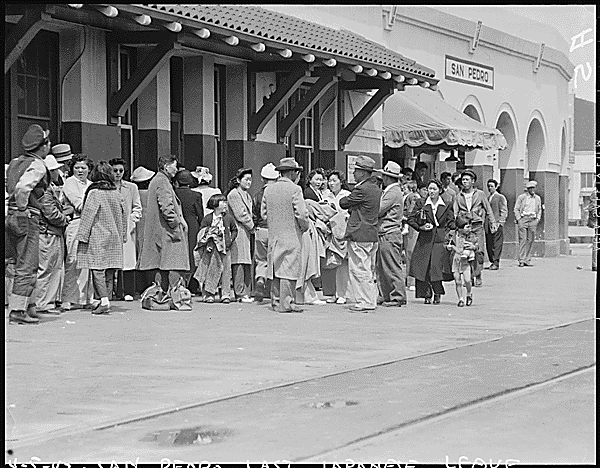The History Reader – Infamy by Richard Reeves
Infamy is the latest work by bestselling author Richard Reeves. It begins in the aftermath of the bombing of Pearl Harbor, an event that inflamed the nation and drew the United States into the Second World War. At this time, President Roosevelt signed an executive order declaring parts of four western states to be a war zone operating under military rule. Thousands of Japanese-Americans were rounded up and forced into imprisonment. Through Reeves’s interviews with survivors and consideration of private letters, memoirs and archives we find a new narrative of this atrocity. Therefore, we’ve asked Reeves to share more details behind his research and writing:
Q: The events in your book happened seventy years ago. Why are they relevant today?
A: The events of 1942—the roundup and incarceration of innocent American Japanese—will always be relevant when there is fear in the land. History repeats itself: from the treatment of British sympathizers after our revolution, to the Trail of Tears, slavery, and repeated prejudice against immigrants. Today’s fears focus on Muslim Americans—and that is why I thought it was the right time to look into the dark corners of our history.
Q: Why is this episode of American history so little-known?
A: The principal cause is that the men and women from the camps simply did not talk about those shameful years, not even to their own children and grandchildren. And because those sad events were not known elsewhere in the country. Many of the men and women held in the camps who relocated in other parts of the country after the war told me their new neighbors knew nothing of what happened.
Q: You spent four years researching and writing this book. What surprised you?
A: I was shocked by the fact that many of those who pushed for concentration camps—and that is what they were called—were the best and the brightest, beginning with President Roosevelt and including Deputy Secretary of Defense John McCloy and California’s attorney general, Earl Warren, Roger Baldwin of the ACLU, journalists Walter Lippman, Edward R. Murrow and even Dr. Seuss.
Q: What was the rounding-up and evacuation like for the victims?
A: It was surprisingly orderly. The Japanese Americans believed they were doing their patriotic duty. Posters went up on telephone poles telling them when and where to appear with only what they could carry. They ended up on sealed trains with curtains drawn heading for barren wastelands, deserts and swamps, where almost no had lived before—or since. Everyone “with a drop of Japanese blood,” including babies and the elderly, lost their homes, their farms, their fishing boats, their jobs, their sense of family.
 The U.S. Army immediately began rounding up thousands of Japanese-Americans, sometimes giving them less than 24 hours to vacate their houses and farms. This particular photo, taken in 1942, depicts a group waiting for a train in San Pedro to a War Relocation Authority center. Image is in the public domain via Wikimedia Commons.
The U.S. Army immediately began rounding up thousands of Japanese-Americans, sometimes giving them less than 24 hours to vacate their houses and farms. This particular photo, taken in 1942, depicts a group waiting for a train in San Pedro to a War Relocation Authority center. Image is in the public domain via Wikimedia Commons.
Q: What were conditions like inside the camps?
A: The prisoners lived in horse stalls and tarpaper barracks, designed for prisoners of war, in places where temperatures were as low as 20-below and as high as 130 degrees, surrounded by barbed wire and guards in machine-gun towers. Amazingly, they turned the camps into enclosed American towns with schools, churches, baseball leagues and Boy Scout troops, their own newspapers and little hospitals.
Q: Were there dissenting voices—Japanese American or not—at the time the events were happening?
A: There were only a few dissenting voices, very few, as prisoners’ cases were blocked in the courts to protect the president and officials like Earl Warren. Four Japanese Americans did fight cases all the way to the Supreme Court, but none were able to end the internment camps. Surprisingly the most prominent official to oppose the roundups was J. Edgar Hoover of the FBI, probably because of his turf war with military authorities. A few small newspapers, the Quakers and other church groups spoke out, but without much impact.
Q: Is there any redemption to be found in these events?
A: The Japanese Americans, the young men redeemed themselves and their families on the battlefield. In Europe, the 442nd, an all-Japanese American unit, were the most highly decorated combatants in American history. In the Pacific, 6,000 Japanese Americans, serving secretly with incredible bravery, persuaded Imperial Japanese soldiers to surrender, interrogated prisoners, and translated communications, leading General McArthur’s staff to say those secret units shortened the war by two years and saved perhaps a million American lives. Then as decades rolled on, American officials, Presidents Ford and Reagan among them, admitted the disgrace of the degradation of these brave American citizens, finally awarding soldiers medals and the surviving former internees small reparations.
Infamy by RICHARD REEVES, and is the bestselling author of such books as President Kennedy: Profile in Power, is an award-winning journalist who has worked for The New York Times, written for The New Yorker, and served as chief correspondent for Frontline on PBS. Currently the senior lecturer at the Annenberg School for Communication and Journalism at the University of Southern California, he lives in Los Angeles. His latest work is Infamy: The Shocking Story of the Japanese-American Internment in World War II.
